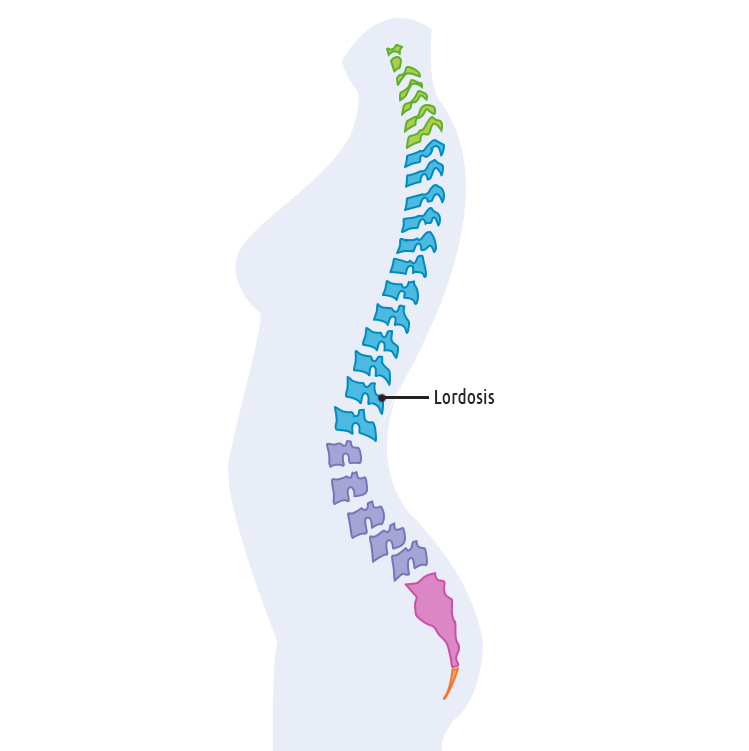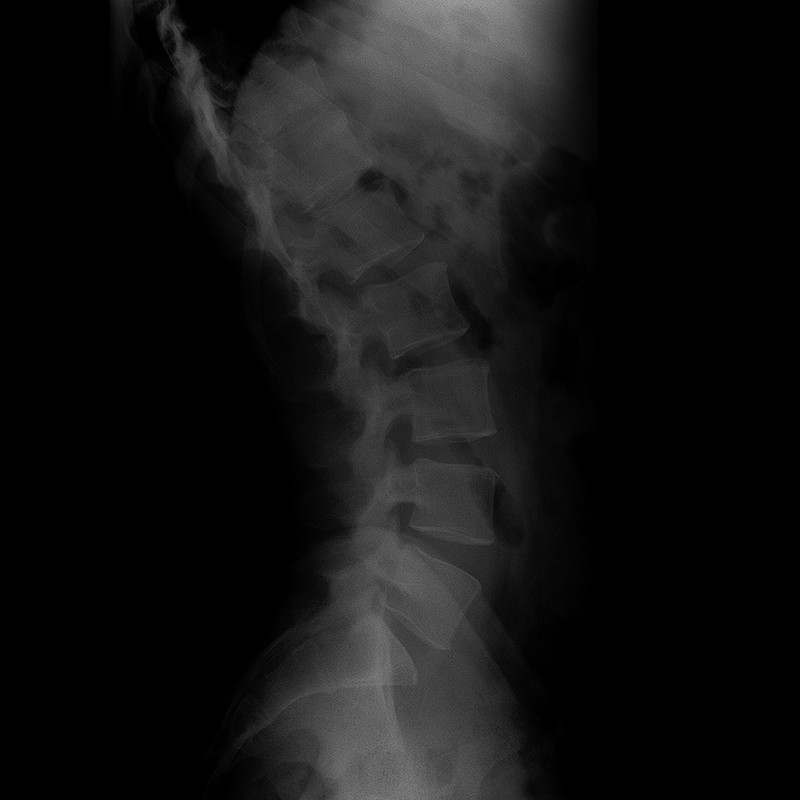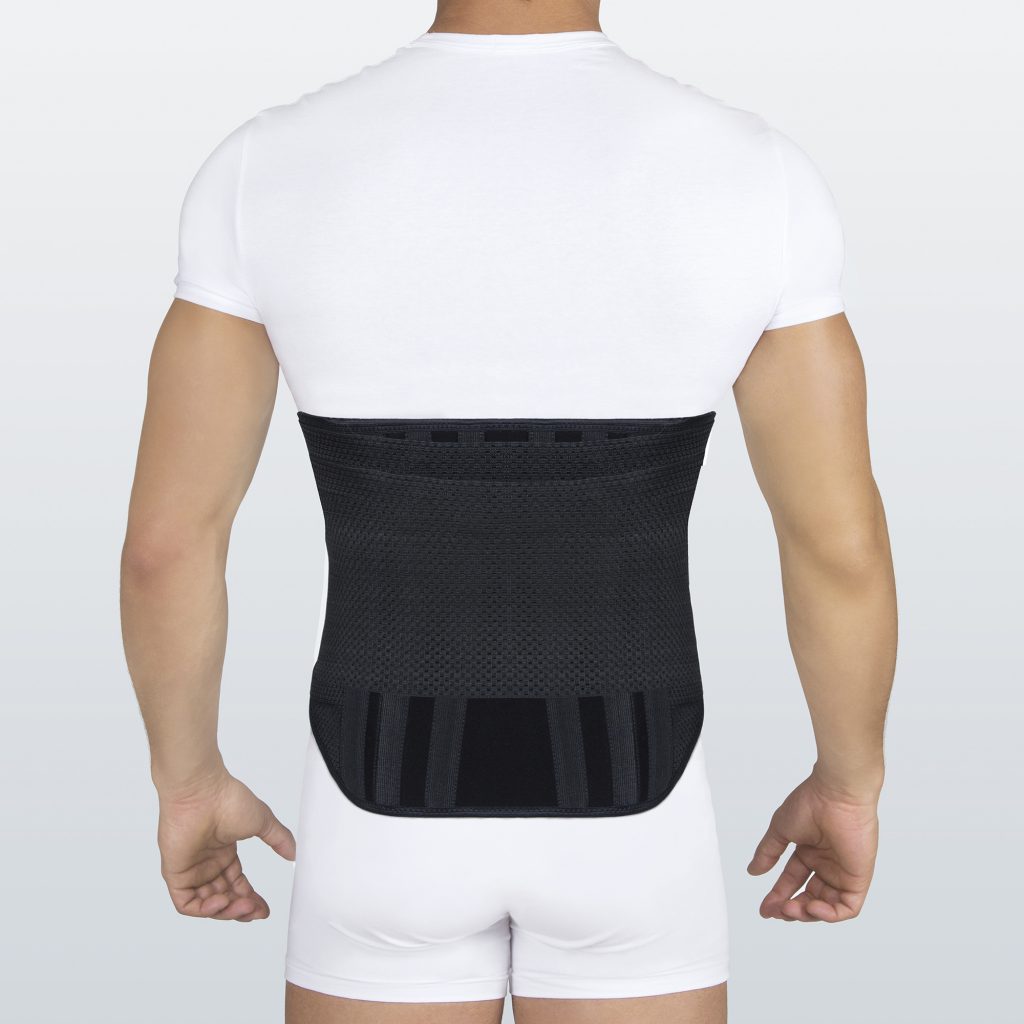Lordosis

What is Lordosis of the Spine?
Everyone's spine bends a little in the neck, upper back, and lower back. These bends, which make your spine's "S" shape, are known as the lordotic (neck and lower back) and kyphotic (upper back). They help your body by doing the following:
- - supports and balances the head
- - absorbs shock
- - keeps the structure of the body stable
- - flexible to move and bend
- - aligns the head over the pelvis

Lordosis of the spine pertains to an individual's characteristic lordotic bend, which is ordinary. However, in the event that an individual's bend curves too far inside, it's called lordosis, or swayback. Lordosis of the spine can influence the lower back and neck. This can prompt an abundance of pressure on the spine, causing pain and uneasiness. It can influence an individual's capacity to move if it's serious and left untreated.
Types of Lordosis:
Lumbar Lordosis
Lordosis in the lower back, or lumbar spine, is the most common diagnosis of spinal abnormalities. The most straightforward approach to check for this condition is to lie on your back on a level surface. You should have the capacity to slide your hand under your lower back, with little space to save.
An individual with Lordosis will have additional space between their back and the surface. In the event that they have an extraordinary bend, there'll be an unmistakable "C" like a curve when they stand. Also, from the side view, their stomach and buttock will protrude.
Cervical Lordosis
In a solid spine, an individual's neck should resemble a wide "C", with the bend indicating the back of the neck. Cervical Lordosis is the point at which an individual's spine in the neck area doesn't bend as it regularly should.
This can mean:
- 1. There's an excess of a bend.
- 2. The bend is curving on the wrong side, likewise called reverse cervical lordosis.
- 3. The bend has relocated to one side (right).
- 4. The bend has relocated to one side (left).
Lordosis of the spine is also known as "sway-back." It is defined as an excessive curve inward of the spine. The natural curvature of the spine allows the head to be positioned over the pelvis. In this position, the curves are able to absorb the shock and distribute the general stress that occurs during movement.
Prevalence
Regularly, Lordosis of the spine shows up in adolescence with no known reason. This is called Considerate Adolescent Lordosis. It happens in light of the fact that the muscles around a child's hips are impaired or even functioning normally. Generally, Adolescent Lordosis commonly corrects itself as the child matures.
Lordosis can likewise be an indication of a hip separation, particularly if an individual had an accident of some sort.
Different conditions that can cause Lordosis of the spine in adolescents are typically identified with the sensory system and muscle issues. These conditions are uncommon and include:
- - Cerebral paralysis
- - Myelomeningocele, an acquired condition where the spinal cord protrudes through a hole in the bones of the back
- - Dystrophy, a disorder in which muscle tissue deteriorates
- - Spinal decay, an acquired condition that causes a loss of proper spinal curve
- - Arthrogryposis, an issue that happens during childbirth where the joints are restricted or constrained to movement
Women that are pregnant quite often experience back pain and show symptoms of Lordosis, a distending abdomen, and buttock. As indicated by Harvard Gaze, Lordosis of the spine amid pregnancy is actually the spine acclimating to realign an individual's center point of gravity.
Recurring back pain most often is due to the changing bloodstream in the body, and will in all probability leave after birth.
Causes of Lordosis
Many different medical conditions can cause abnormal curvatures of the spine, including Lordosis of the spine. Some of these conditions include:
- Achondroplasia: This condition leads to short stature due to abnormal bone growth.
- Spondylolisthesis: In this condition, the vertebrae in the lower spinal column slip forward.
- Osteoporosis: This is a condition in which bones become soft, thin and can be broken easily. This can lead to lordosis.
- Obesity: Being overweight can lead to deformities of the spine.
- Kyphosis: In this condition, the upper curve of the spine is exaggerated outward.
- Discitis: This is the inflammation of one or several of the discs that lie between the vertebrae.
- Tension in the muscles of the lower back can lead to lordosis
- Pregnancy often causes lordosis
- Rickets: a disease caused by a lack of Vitamin D in the body
Risk factors
The following factors increase an individual's risk of developing lordosis of the spine:
- - A history of back surgery
- - Disorders related to an individual's hips
- - Kyphosis or hunchback, also sometimes called Dowager's hump
- - Osteoporosis, sometimes called thinning bones or brittle bones can cause lordosis
- - Disc problems such as herniated, slipped or bulging discs
- - Being overweight or obese can contribute to lordosis
Complications
A small level of Lordosis and Kyphosis is typically present in the spine. On the off chance that Kyphosis is excessive, it causes round shoulders which are called Scheuermann' Disease. Excessive lordotic bending is known as Lordosis or "swayback".
Adolescents experiencing excessive Lordosis of the spine will have a space underneath their lower back when lying on their back on a hard surface. At the point when a lordotic bend is adaptable, it is for the most part, not a worry. At the point when the bend does not move, therapeutic assessment is required. Timber and cervical sections of the vertebral segment are regularly lordotic (convexity anteriorly and concavity posteriorly). Front pelvic tilt is a central point of Lordosis. Individuals with Lordosis regularly demonstrate a noticeable curve in their lower backs. When observed from the side, the individual's lower back shows a characterized "C" shape.
Individuals with Lordosis appear to be protruding from their abdomen and buttocks. Amid examination of the individual with Lordosis, request that the individual lies on their back on a hard surface, then slide their hand under the lower back. There should be little space between the hand and lower back. In the event that the individual has Lordosis, he or she will have additional space between their hand and lower back.

Lordosis Symptoms
The most widely recognized Lordosis symptom is muscle pain. At the point where an individual's spine bends unusually, the muscles get pulled in various directions, causing them to become tight or fixed. In the event that an individual has Cervical Lordosis symptoms, this pain may extend to the neck, shoulders, and upper back. An individual may likewise encounter restricted development in the neck or lower back.
Individuals should check for Lordosis symptoms by lying on a flat surface and checking if there's a considerable measure of space between the curve of the neck and back and the floor.
Individuals should see a physician in the event that they are encountering different manifestations, for example,
- a) numbness
- b) shivering
- c) tingling
- d) decreased bladder control
- e) lack or loss of muscle control
These might be indications of a more common condition, for example, a pinched nerve.
Lordosis symptoms depend on the severity of the abnormal curvature of the spine. Lordosis symptoms may include:
- - The back will appear like the letter "C" when viewed from the side and the buttocks will protrude more evidently.
- - When lying on a flat surface, there will a large gap between the surface and the individual's lower back.
- - Pain in the lumbar (lower) back area can be a Lordosis symptom
- - Pain due to a particular movement
Diagnostic procedures
It is difficult at times for physicians to diagnose and measure the progression of lumbar (lower back) lordosis and the lordosis symptoms. This is because sometimes the vertebrae become fused together and this adds to the progression of the disorder. Certain vertebrae of the lumbar spine are involved in normal spinal curvature so sometimes doctors will use these to accurately measure the progression of lordosis symptoms.
A physician should review an individual's therapeutic history, conduct a physical exam, and gather information about different side effects to help decide whether the individual has Lordosis symptoms or not. Amid the physical exam, the physician will request that the individual twist forward and to the side. They're checking for the following:
- 1. acceptable flexibility
- 2. the scope of movement
- 3. spine positioning and curvature
- 4. anomalies
Additionally, the physician will inquire about the following:
- - Is the bend deteriorating?
- - Is the bend evolving shape?
- - Where is the point of pain?
In the wake of narrowing down the conceivable causes, the physician will arrange tests, including X-rays of the spine to examine the point of the lordotic bend. Additionally, the physician will determine whether the individual has Lordosis by considering components like stature, age, and body mass.
Physical Examination
Intensive physical examinations uncover a great deal about the well-being and general wellness of the individual. The doctor will need to know when the ebb and flow was first seen, past movement, and other related side effects the individual encounters. The exam gives a pattern from which the doctor can quantify the individual symptoms amid treatment. The physical exam may include:
1. Palpation determines spinal irregularities by feel.
2. The scope of Motion measures how much an individual can move their body. Lordosis symptoms often affect a person's range of movement due to pain and stiffness.
Neurologic Evaluation
A neurological assessment incorporates an evaluation of the accompanying manifestations: pain, numbness, paresthesias (e.g. shivering), motor skills, muscle fitness, and bladder changes.
Radiographic (X-Rays)
The patient stands to uncover the whole length of the spine when PA (back/foremost, or back and front) and Lateral (side) x-beams are taken. Side twisting APx-rays is occasionally used to assess spinal adaptability. An MRI might be requested if the spinal line has been bargained (or suspected).

One Lordosis symptom that is easily recognizable is the exaggerated arch of the lower portion of the back. In order to make an accurate diagnosis, the physician will review the individual's medical history, complete a thorough physical examination and may order other tests.
Other tests to help when diagnosing lordosis may include:
- X-ray: These can measure the curvature of the lumbar spine and the degree of lordosis symptom
- Bone Scan: The physician may order a bone scan to rule out possible causes for the abnormal lordosis, such as infection or fractures.
- Magnetic Resonance Imaging (MRI): This can be used to evaluate the spinal cord and nerves and eliminate any problems with these that could be causing lordosis symptoms.
- Computerized Tomography Scan (CT scans): These give the physician very detailed images of the muscles, bones, and organs of the lumbar area of the body.
Lordosis Treatment
Lordosis treatment depends on the severity of the symptoms it is causing. Some people don't have any pain or other adverse symptoms but others experience pain that makes moving difficult. Unless the symptoms are severe, most physicians will try conservative lordosis treatment which may include:
- Medication to help manage pain and reduce swelling and inflammation
- Physical therapy to help improve flexibility and mobility, and build endurance and strength
- Braces may be prescribed to help control lordosis, especially when a child or teen is treated because they are still growing.

- Decreasing body weight if indicated, to within a healthy range to help control lordosis
Lordosis treatment can be done non-surgically through recovery works out. If a wide range of activities is done effectively, it might lessen side effects of Lordosis in 3-6 months. Chiropractors and some physical specialists are a portion of the professionals who aid such recovery treatment, however, it is not extremely normal.
Lordosis treatment or swayback of the lower back starts by fortifying the hip extensors, which are situated at the back of the thigh, and by extending the hip flexors (a muscle that curves a joint or appendage when it is contracted) situated at the front of the thigh.
The muscles on the front and back of the thighs can turn the pelvis forward or in reverse being in a standing position since they can put on the ground through legs and feet.
Importance is given to the abs to keep up an impartial spine position. The muscular strength forestalls Lordosis by driving the inward body organs against the spine, henceforth decreasing the lumbar arch; however, they are not very supportive of standing position.
If the degree of curvature in Lordosis is extreme and is causing severe symptoms, the doctor may recommend surgery as a Lordosis treatment. Kyphoplasty, artificial disc replacement, and spinal instrumentation are potential Lordosis treatments.
Non-Surgical Lordosis Treatment
Non-surgical moderate treatment measures may include:
1. Analgesics and mitigating pharmaceutical.
2. Active recuperation empowering the patient to manufacture quality, adaptability, and increment scope of movement. The advisor may give a tweaked home exercise program.
3. Propping might be utilized control bend movement in young people.
4. Lessening of body weight.
5. Surgery might be considered if the lordotic bend is serious with a neurological contribution.
Spine Surgery
Surgical intercession is considered if the lordotic bend is serious when neurologic association exists, or non-surgical moderate treatment has neglected to give alleviation. A spine specialist chooses which surgical methodology and approach (foremost/back, front or back) are best for the patient. These choices depend on the patient's medicinal history, manifestations, and radiographic discoveries. An assortment of surgical treatment choices is used. Individuals should speak to their physician about what treatment is best.
Recuperation
Regardless of whether the treatment course is preservationist or surgical, it is critical to adhere to the doctor as well as physical advisor's guidelines. Talk about any worries about action limitations. They will have the capacity to recommend safe options. Exercise-based recuperation might be joined into the treatment intends to fabricate quality, adaptability, and increment scope of movement. The advisor may give the individual a regular home exercise program. On the off chance that the individual experiences spine surgery, composed directions, and prescribed medications are offered preceding discharge from the doctor's facility.
Prevention
Some types of Lordosis cannot be prevented, but an individual can take steps to reduce their risk of developing conditions which contribute lordosis. Some of these steps include:
- Maintain a healthy weight
- Quit smoking
- Make sure your daily intake of calcium and vitamin D is adequate to prevent lordosis
- Get some form of weight-bearing exercises, such as walking, routinely
- Practice good posture to prevent lordosis
Tips on How to Prevent Lumbar Lordosis
There are numerous sorts of activities and extends to browse, contingent upon an individual's age and their level of wellness. Yoga and seat yoga are great decisions. The critical thing is to build up an activity schedule that can be adhered to. Posture is an important factor when sitting, standing, or taking part in exercises.
Here are some basic exercises that require no gear:
- Propel your shoulders and up toward your ears and after that withdraw, pushing out toward your back.
- Extend your arms upward to shoulder height, and move them in small circles.
- Standing up, squat as if you were sitting in a seat.
- Standing with your arms resting beside you, bend side to side extending the arm down into the bend.






